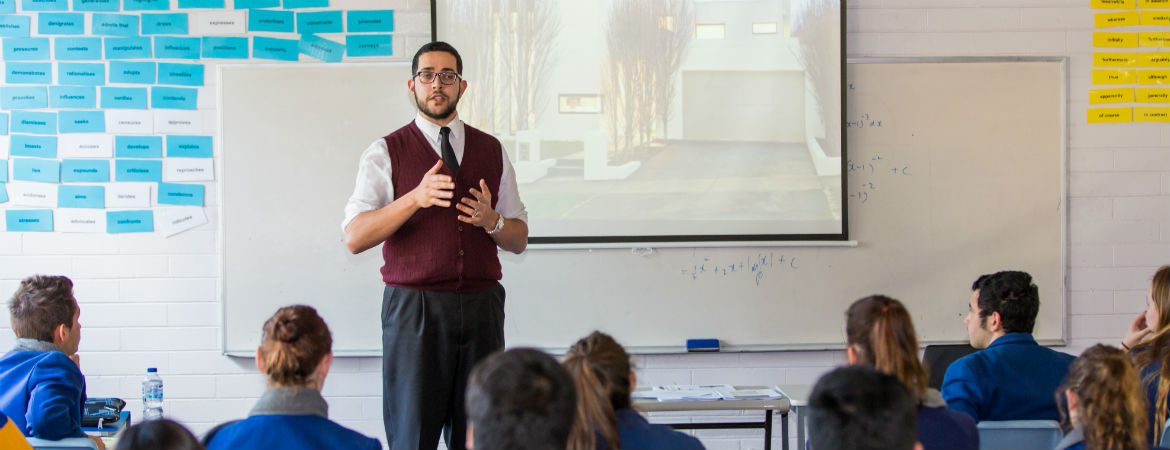
The Food 4 Thought resource will help your students get more actively involved in fair trade — just like the kids at St Monica’s.
Fadi Elbarbar is the Social Justice Coordinator at St Monica’s in Epping, Victoria. Apart from being a star teacher and all round lovely guy, he also won the Fairtrade Australia & New Zealand’s Fairtrade Supporter of the Year Award last year for his work in leading St Monica’s to become a Fairtrade school!
Last month, Fadi shared his experiences of using Food 4 Thought — Oxfam Australia’s Geography education resource — with his entire Year 9 cohort (more than 250 students!) at the recent GTAV conference in Melbourne.
Today his guest blog recaps on his reflections, which we hope will inspire teachers to get creative and embed the Food 4 Thought resource into their curriculum.
Fadi’s thoughts:
For the past two years, the Year 9 students at St Monica’s College have been immersed in the world of fair trade and conscious consumerism through their Year 9 Geography classes. We’ve mainly done this through incursions, where the concept and benefits of fair trade were introduced to them.
However at the end of 2014, I discussed with the Humanities Coordinator how we could improve what we were doing — not only in how we could incorporate social justice further, but how we could get the students to be more actively involved in learning about fair trade, rather than being told about it.
So when I was introduced to the Food 4 Thought resource, for us, it was the perfect solution. In our first year, we introduced the resource as a total booklet for students, to complement our text book (Jacaranda’s Geography Alive 9) and incorporate those activities with what we already do at the appropriate times.
When it was time to look at solutions for food security, we organised guest speakers from various organisations to come and speak about what fair trade is and how it helps their company help others.
We had eight different speakers come throughout Fairtrade Fortnight to speak to the students. Students from different classes then compared what they’d learnt from the different guest speakers, which was an effective way of deepening and reflecting on their experiences.
We also switched up the final activity of Food 4 Thought — What can WE do to improve food security? — to tailor it to our school’s focus and context. Instead of creating a variety of community campaigns on food security, the students’ final action was to write letters to organisations that have no Fairtrade certifications and asked them to think about doing so, explaining the benefits in regards to what they had learnt. This was also used as their assessment piece.
The Food 4 Thought resource was an excellent companion resource to the work that we do, as it really broadened their knowledge, inspired them to act and brought their learning into the real world, rather than relying on the textbook. It’s been extremely successful for us, and we look forward to using it again next year.
Fadi’s top 3 tips for teachers using Food 4 Thought for the first time:
1. Familiarise yourself with the plethora of online tools available to you with this resource from a student’s perspective. It’s designed for online use and students get so much out of it that way.
2. Link it to your textbook: We use Geography Alive 9 (Jacaranda Plus), and it links really well. For example:
• GA9 Chapter 1 matches with F4T Which Biomes are able to produce food
• GA9 Chapters 2-3 matches with F4T Major Challenges to Food Production – Climate Change, and Major Challenges to Food Production – Land Use
• GA9 Chapters 5 & 8 matches with F4T How Can Food Security be Achieved in the Future, and What can WE do to improve food security?
3. Food 4 Thought has excellent additional extension activities for students who are advanced and looking to be challenged. However it lacks activities that are easily modified for those who are really struggling. This is where having close links to the textbook really helps.
Oxfam has more ways to learn about Food Security in Term 4 – hold a Hunger Banquet for an experiential activity that explores global hunger and what young people can do to help create a world where everyone has enough to eat. Register to download our free Hunger Banquets resources online.